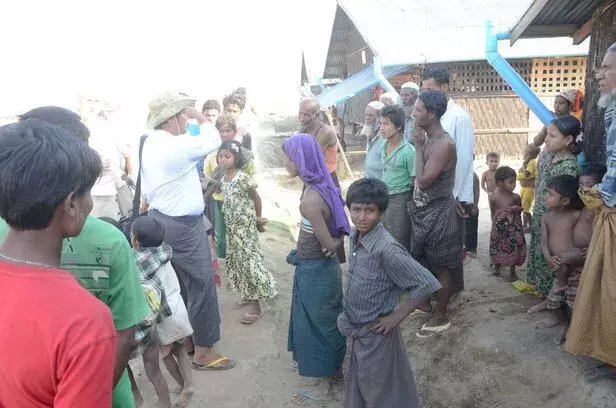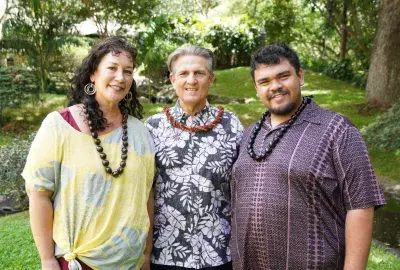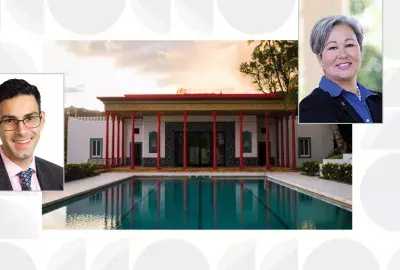Error message

OFFICE/DEPARTMENT
A new report explores why millions of stateless people across Southeast Asia lack legal citizenship or identity
Quick take:
- While some of Southeast Asia’s many stateless individuals are refugees or migrants, most are minorities in the countries of their birth.
- Discriminatory policies against such populations are a prime cause of statelessness in the region, along with increasing cross-border migration.
- In the wake of humanitarian crises like the violent forced exit of Rohingya Muslims from Myanmar, some governments in the region have been making efforts to reduce the numbers of those living without full social, political, and economic rights.
HONOLULU (June 23, 2021)—Across Southeast Asia, millions of people are stateless, either by circumstance or design. Some of those lacking legal national identity are refugees or migrants, but most are minorities in the countries of their birth, many living without adequate access to critical services like health care and education.
Some progress is being made, however. A recent East-West Center analysis examining the status of these populations found that several governments and civil organizations have taken steps in the past decade to address the complex causes of statelessness. “Since the forced mass exodus of Rohingya from Myanmar, many have reached the shores of Malaysia and Indonesia, driving home the implications of unresolved situations of statelessness,” writes researcher Christoph Sperfeldt in Legal Identity and Statelessness in Southeast Asia, part of EWC’s AsiaPacific Issues series of analysis papers. “Policy responses of states in the region have focused on identifying affected persons, improving civil registration, law reforms, facilitating naturalization, and building new digital identification systems.”
Discriminatory policies
While there is growing recognition that resolving issues of statelessness and legal identity is a critical factor in the region’s development, major challenges remain, according to Sperfeldt, an honorary fellow at the Peter McMullin Centre on Statelessness at the University of Melbourne and a collaborating scholar for the East-West Center’s partnership with the Center for Human Rights and International Justice at Stanford University.
Southeast Asia's “long shadow” of colonial rule accounts in part for the continuing exclusion of certain populations from full citizenship, he writes, arguing that “ethnicity and nationhood are Western-derived concepts that were embraced and modified by Southeast Asian countries during the twentieth century.”
Weak government systems, notably for birth registrations, leave many without documents proving their parentage or place of birth. A lack of legal safeguards against the loss of nationality can add to the problem, such as when women lose their citizenship through marriage to a foreigner.
But in many cases, Sperfeldt writes, discriminatory policies are what drive people into statelessness even in the country of their birth, jeopardizing their access to such basic services as health care. Counted among these populations in Southeast Asia are the Rohingya in Myanmar, Thailand’s Hill Tribes, certain Vietnamese minorities in Cambodia, and Chinese populations in Brunei. According to Sperfeldt, "It is no coincidence that 75 percent of the known stateless populations worldwide belong to minorities."
Gender laws can further deny equal rights to women. In Brunei, for example, only fathers can confer nationality on their children, a restriction that particularly affects those born of mixed marriages or outside the country.
Rising cross-border migration
Increasing cross-border labor and other migration contributes to Southeast Asia’s stateless populations as well, Sperfeldt writes. Migration can occur outside normal regulatory channels, with human trafficking a factor in the movement of people across borders.
Mobility also impacts ‘sea nomads’, he writes, among them the Moken of the Andaman Sea and the Bajau Laut of the Sulu Sea, many of whom lack citizenship in the territory where they live due to discrimination and their marine lifestyles.
In addition, Sperfeldt asserts:“A lack of legal protection, restrictive immigration regimes, limited rights for temporary workers, and low registration rates among migrants often create conditions where children grow up without proof of legal identity, putting them at risk of statelessness."
Improvement efforts
Despite a myriad of issues, Sperfeldt writes, some governments are making efforts to reduce the numbers of those living without full social, political, and economic rights:
- In 2016, Thailand committed to a goal of "zero statelessness," while the Philippines signed on to relevant international conventions and issued a national action plan in 2017 to end statelessness by 2024.
- To resolve the status of long-term residents of Indonesian descent in the Philippines, the government conferred citizenship to more than 90 percent of the 8,745 individuals it had registered by 2019.
- In 2010, Vietnam eased naturalization requirements for Cambodians who fled from atrocities in the 1970s. After three decades in limbo, the displaced individuals and their children were allowed to obtain Vietnamese nationality.
- A collaboration between government and NGOs identified and registered Indians of Tamil descent who had migrated to Malaysia during British colonial rule. Since 2014, about 12,350 people were helped to register and apply for nationality. "The case shows how community-based assistance programs can help to overcome fears among affected populations about certain government registration schemes," according to Sperfeldt.
Widespread trouble areas remain
Countries including Myanmar and Cambodia have yet to resolve the status of stateless populations within their borders, Sperfeldt writes. Cambodia has launched a census of its Vietnamese minority but it remains unclear if this will lead to Cambodian nationality or another kind of legal status.
In his analysis, Sperfeldt calls for an escalation of efforts to resolve statelessness and other legal identity issues still widespread in the region. Such steps include raising awareness to address long-held views about identity and belonging, increasing capacity among officials to deal with the issues, and expansion of naturalization programs. Attention needs to be focused on addressing the "more intractable and politically sensitive situations that cannot be resolved through technical assistance and law reform alone," he concludes.
Photo: Rohingya internment in camp in Sittwe, Myanmar, 2014. Credit: Greg Knudsen
A new report explores why millions of stateless people across Southeast Asia lack legal citizenship or identity
Quick take:
- While some of Southeast Asia’s many stateless individuals are refugees or migrants, most are minorities in the countries of their birth.
- Discriminatory policies against such populations are a prime cause of statelessness in the region, along with increasing cross-border migration.
- In the wake of humanitarian crises like the violent forced exit of Rohingya Muslims from Myanmar, some governments in the region have been making efforts to reduce the numbers of those living without full social, political, and economic rights.
HONOLULU (June 23, 2021)—Across Southeast Asia, millions of people are stateless, either by circumstance or design. Some of those lacking legal national identity are refugees or migrants, but most are minorities in the countries of their birth, many living without adequate access to critical services like health care and education.
Some progress is being made, however. A recent East-West Center analysis examining the status of these populations found that several governments and civil organizations have taken steps in the past decade to address the complex causes of statelessness. “Since the forced mass exodus of Rohingya from Myanmar, many have reached the shores of Malaysia and Indonesia, driving home the implications of unresolved situations of statelessness,” writes researcher Christoph Sperfeldt in Legal Identity and Statelessness in Southeast Asia, part of EWC’s AsiaPacific Issues series of analysis papers. “Policy responses of states in the region have focused on identifying affected persons, improving civil registration, law reforms, facilitating naturalization, and building new digital identification systems.”
Discriminatory policies
While there is growing recognition that resolving issues of statelessness and legal identity is a critical factor in the region’s development, major challenges remain, according to Sperfeldt, an honorary fellow at the Peter McMullin Centre on Statelessness at the University of Melbourne and a collaborating scholar for the East-West Center’s partnership with the Center for Human Rights and International Justice at Stanford University.
Southeast Asia's “long shadow” of colonial rule accounts in part for the continuing exclusion of certain populations from full citizenship, he writes, arguing that “ethnicity and nationhood are Western-derived concepts that were embraced and modified by Southeast Asian countries during the twentieth century.”
Weak government systems, notably for birth registrations, leave many without documents proving their parentage or place of birth. A lack of legal safeguards against the loss of nationality can add to the problem, such as when women lose their citizenship through marriage to a foreigner.
But in many cases, Sperfeldt writes, discriminatory policies are what drive people into statelessness even in the country of their birth, jeopardizing their access to such basic services as health care. Counted among these populations in Southeast Asia are the Rohingya in Myanmar, Thailand’s Hill Tribes, certain Vietnamese minorities in Cambodia, and Chinese populations in Brunei. According to Sperfeldt, "It is no coincidence that 75 percent of the known stateless populations worldwide belong to minorities."
Gender laws can further deny equal rights to women. In Brunei, for example, only fathers can confer nationality on their children, a restriction that particularly affects those born of mixed marriages or outside the country.
Rising cross-border migration
Increasing cross-border labor and other migration contributes to Southeast Asia’s stateless populations as well, Sperfeldt writes. Migration can occur outside normal regulatory channels, with human trafficking a factor in the movement of people across borders.
Mobility also impacts ‘sea nomads’, he writes, among them the Moken of the Andaman Sea and the Bajau Laut of the Sulu Sea, many of whom lack citizenship in the territory where they live due to discrimination and their marine lifestyles.
In addition, Sperfeldt asserts:“A lack of legal protection, restrictive immigration regimes, limited rights for temporary workers, and low registration rates among migrants often create conditions where children grow up without proof of legal identity, putting them at risk of statelessness."
Improvement efforts
Despite a myriad of issues, Sperfeldt writes, some governments are making efforts to reduce the numbers of those living without full social, political, and economic rights:
- In 2016, Thailand committed to a goal of "zero statelessness," while the Philippines signed on to relevant international conventions and issued a national action plan in 2017 to end statelessness by 2024.
- To resolve the status of long-term residents of Indonesian descent in the Philippines, the government conferred citizenship to more than 90 percent of the 8,745 individuals it had registered by 2019.
- In 2010, Vietnam eased naturalization requirements for Cambodians who fled from atrocities in the 1970s. After three decades in limbo, the displaced individuals and their children were allowed to obtain Vietnamese nationality.
- A collaboration between government and NGOs identified and registered Indians of Tamil descent who had migrated to Malaysia during British colonial rule. Since 2014, about 12,350 people were helped to register and apply for nationality. "The case shows how community-based assistance programs can help to overcome fears among affected populations about certain government registration schemes," according to Sperfeldt.
Widespread trouble areas remain
Countries including Myanmar and Cambodia have yet to resolve the status of stateless populations within their borders, Sperfeldt writes. Cambodia has launched a census of its Vietnamese minority but it remains unclear if this will lead to Cambodian nationality or another kind of legal status.
In his analysis, Sperfeldt calls for an escalation of efforts to resolve statelessness and other legal identity issues still widespread in the region. Such steps include raising awareness to address long-held views about identity and belonging, increasing capacity among officials to deal with the issues, and expansion of naturalization programs. Attention needs to be focused on addressing the "more intractable and politically sensitive situations that cannot be resolved through technical assistance and law reform alone," he concludes.
Photo: Rohingya internment in camp in Sittwe, Myanmar, 2014. Credit: Greg Knudsen
East-West Wire
News, Commentary, and Analysis
The East-West Wire is a news, commentary, and analysis service provided by the East-West Center in Honolulu. Any part or all of the Wire content may be used by media with attribution to the East-West Center or the person quoted. To receive East-West Center Wire media releases via email, subscribe here.
For links to all East-West Center media programs, fellowships and services, see www.eastwestcenter.org/journalists.







